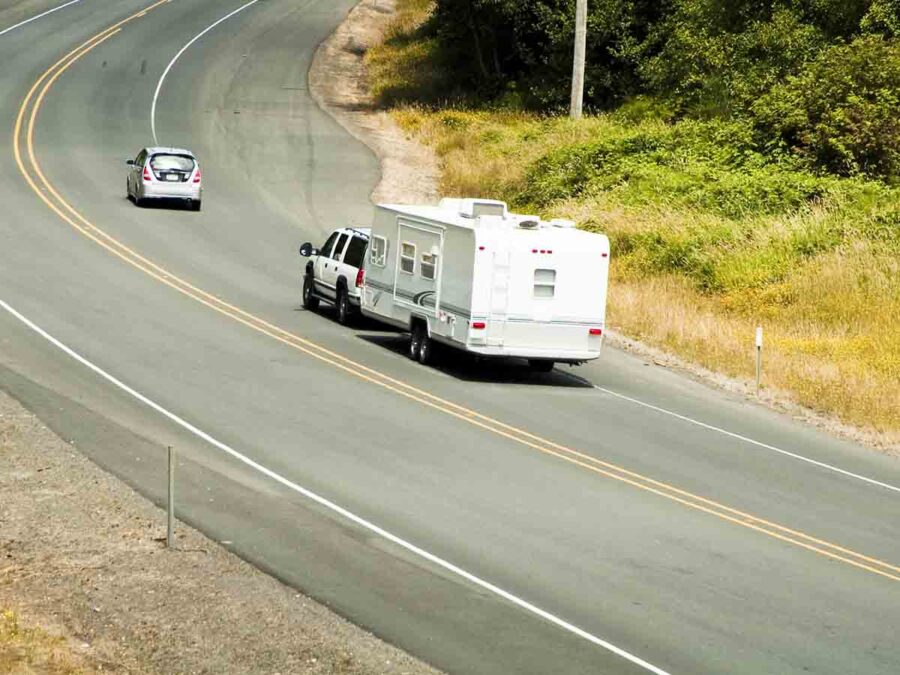Have you ever found yourself staring at an RV, wondering what it would be like to hitch it to your vehicle and head out into the open road? The freedom of the open road, the comfort of a home on wheels, and the adventure waiting at every turn make RV towing an enticing prospect. Yet, for many, the thought of towing an RV can seem daunting.
How do you manage such a large vehicle? What are the essential skills you need? Fear not, for this article is designed to demystify the process and provide you with the knowledge to confidently tow your RV.
Towing an RV requires a blend of preparation, understanding, and practice. From selecting the right tow vehicle and understanding the weight ratings to mastering the art of driving with a larger load, there’s a lot to consider.
When I was new to RVing and got my first travel trailer, I felt woefully unprepared for towing. Until then, my only experience with towing had been hauling items in the bed of my pickup truck.
After a heart-stopping moment when my trailer began to sway alarmingly on a busy highway, I urgently recognized the need to learn more about towing. In my situation, I realized the cause of the swaying was an uneven distribution of my load. This imbalance not only led to the swaying but also diminished the accuracy of my steering and placed additional stress on my truck’s engine and braking system.
In the following guide, I’ll be sharing nine essential points for how to properly tow your RV.
1. Understand Towing Capacity
Before anything else, know your truck’s towing capacity.
This is the maximum weight your vehicle can safely tow.
Here’s an example of the towing capacity of several 2024 towing vehicles.
| YEAR | MAKE | MODEL | TOWING CAPACITY (LBS) |
|---|---|---|---|
| 2024 | Ford | F-150 | 13,000 |
| 2024 | Chevrolet | Silverado 1500 | 13,500 |
| 2024 | Ram | 1500 | 12,750 |
| 2024 | Toyota | Tundra | 10,400 |
| 2024 | Nissan | Titan | 9,740 |
Exceeding this limit can lead to significant handling, performance, and braking issues, as well as potential damage to your vehicle.
Understanding your towing vehicle’s towing capacity is important because it directly impacts the safety and efficiency of your vehicle when towing. The manufacturer determines this limit based on the vehicle’s design, engine power, braking capability, and structural integrity.
Exceeding the towing capacity can strain the engine, transmission, and brakes, leading to decreased performance, increased wear and tear, and the risk of accidents due to inadequate control and stopping power.
Related reading: How to Increase Towing Capacity
2. Check the Gross Vehicle Weight Rating (GVWR)
Each RV has a GVWR, which is the maximum weight the RV can safely handle, including its own weight, plus passengers, cargo, and fluids.
Ensure your load does not exceed this rating.
Let’s look at a simple example to get a better feel for this.
Imagine a mid-size pickup truck that has a Gross Vehicle Weight Rating (GVWR) of 7,000 pounds. This rating includes the weight of the truck itself (let’s say 5,000 pounds) plus the maximum load it can safely carry, which would be 2,000 pounds in this case.
The GVWR is a fixed value set by the manufacturer that indicates the maximum total weight of the vehicle, which includes passengers, cargo, and any additional equipment installed on the vehicle that it can handle without risking damage or unsafe conditions.
3. Distribute Weight Evenly
Aim to distribute weight evenly from side to side and front to back within the RV.
Heavy items should be placed low to the ground and as close to the axles as possible to maintain a low center of gravity and reduce the risk of sway.
4. Load Heavier Items Forward
Place heavier items toward the front of the RV (but not too far forward) to achieve a proper tongue weight, which is typically recommended to be between 10-15% of the RV’s total weight.
An incorrect tongue weight can lead to swaying and loss of control.
5. Use a Weight Distribution Hitch
A weight distribution hitch can help evenly distribute the load over the trailer’s and vehicle’s axles.
- Sturdy and Robust: High-strength hardened steel components and construction offer exceptional long-term durability, remaining…
- 4-Point Swivel Control: Provides swivel control to limit lateral movement during trailer towing. It employs fixed support brackets…
- Weight Distribution: The weight distribution hitch distributes the total weight of the trailer onto the vehicle and trailer axles,…
- Wear-Resistant and Rust-Proof: To minimize friction damage between components, the brackets feature a straight plate design,…
- Easy Installation: This VEVOR trailer hitch is designed for quick and easy installation and adjustment. We provide a pry bar…
It reduces strain on the vehicle and improves steering and braking control by leveling the load and reducing or eliminating sag.
“Sag” refers to the lowering of a vehicle’s rear end that occurs when it is heavily loaded or towing a trailer, causing an imbalance in the vehicle’s posture. This condition can compromise the vehicle’s handling, making steering and braking less effective.
By leveling the load and minimizing or eliminating sag, the vehicle maintains a more balanced stance, enhancing steering precision and braking efficiency, thereby improving overall safety and performance.
6. Regularly Check Tire Pressure
Ensure your truck and RV tires are properly inflated according to the manufacturer’s specifications.
Incorrect tire pressure can affect towing stability and cause uneven tire wear.
Incorrect tire pressure affects towing stability because it alters the tire’s contact patch with the road, leading to reduced grip and handling precision. Overinflated tires can decrease the contact area, while underinflated tires can cause excessive flexing and heat buildup.
This imbalance not only compromises stability during towing but also leads to uneven tire wear, with either the center or edges wearing out more quickly, reducing the tire’s lifespan and safety.
Want to Connect With a Community of Over 1,078 RV Enthusiasts?
Related reading: The Hidden Dangers of Ignoring Your Tires and TPMS
To check tire pressure, you need a reliable tire pressure gauge and, if adjustments are needed, an air compressor or a manual pump. These tools enable you to measure and adjust your tire’s pressure to ensure it matches the manufacturer’s recommended levels.
7. Secure All Cargo
Make sure all cargo inside the RV is secured and won’t shift during travel.
Shifting weight can cause imbalance and affect the vehicle’s handling.
8. Practice Towing
If you’re new to towing, practice driving with the RV attached in a safe, open area to get used to the differences in handling, especially for backing up, turning, and braking.
For those new to towing, there are electronic devices designed to assist with the challenges of handling a vehicle with an RV attached.
Backup cameras and sensor systems can greatly improve visibility behind the RV, making reversing and parking much easier.
Additionally, electronic brake controllers can be installed to ensure that the RV’s brakes are synchronized with the towing vehicle’s brakes, providing smoother and more effective braking.
There are also advanced driver assistance systems (ADAS) available that include features like trailer sway control and blind-spot monitoring specifically designed for towing scenarios, enhancing safety and confidence while driving.
9. Conduct Pre-Trip Inspections
Before any trip, check that your load is properly distributed and secured, and inspect the hitch system and connections to ensure everything is tight and in good working order.
Adhering to these guidelines can help ensure a safer towing experience.
If you’re unsure or need specific advice for your vehicle and RV combination, consulting the owner’s manuals or a professional is always a good practice.
Summary
Careful adherence to these 9 principles of weight distribution and towing safety not only enhances the performance and reliability of your towing setup but also significantly mitigates the risks associated with towing an RV.
By understanding your vehicle’s capabilities, properly distributing and securing your load, and conducting regular checks, you can ensure a safe and enjoyable journey on the road, making your adventures with your RV both memorable and secure.
Observe the Dangers of the Wrong Weight Distribution (Video)
"Man cannot discover new oceans unless he has the courage to lose sight of the shore."
-- Andre Gide












